Memorial Swinging Bridge
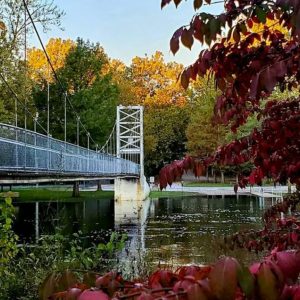 The Memorial Swinging Bridge is approaching its centenary anniversary.
The Memorial Swinging Bridge is approaching its centenary anniversary.
The bridge was proposed as a permanent footbridge to connect the town’s new campground with the newly-refurbished river park. All permanent bridges having been lost to flooding, this bridge was meant to replace the temporary bridges that had been used “in season” for several years. The hope was to create a tourist destination for the town.
In 1923, the County was still in mourning for veterans lost in the Great War. Because of that, the bridge was dedicated to veterans on July 4, 1923. The inscription on the bridge itself reads:
Memorial Bridge
Dedicated to the Soldiers and Sailors
From Pulaski County
Memorial spans the Tippecanoe River connecting the main area of the Town Park (on the peninsula) with the smaller section of the park. Vehicular bridges have spanned the river south and north of that area, replaced on occasion when they lost their battle with the river, but solutions for pedestrians took a back seat.
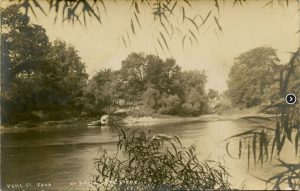
Temporary pedestrian bridges were placed in the vicinity of Memorial’s location until 1886. An iron footbridge was erected that year, but it did not outlast the river. Another “permanent” footbridge was placed in 1892. That bridge had to be moved immediately, as the sand on the river bottom caused the walk to settle unevenly. When that bridge was eventually destroyed, the Town resorted to their original solution, temporary wooden bridges placed “in season.”
The Tippecanoe River floods every year. Some years, flooding is severe, particularly at the area of the horseshoe bend surrounding the park. R. E. Nutt, the engineer and eventual contractor for Memorial, developed specifications to place the bridge well above danger from high water. He designed a single span suspension bridge, 200 feet long and five feet wide, with steel towers embedded in concrete. Steel suspension cables stretch from tower to tower, and suspender cables hold the deck in place.
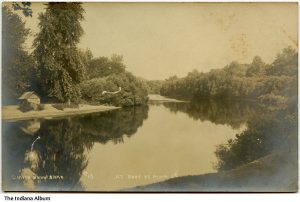
Research into Mr. Nutt’s background unearthed campaign materials as he ran for and secured election to the office of Pulaski County Surveyor. In those materials, he touted his experience as a bridge builder. Research did not ascertain for whom he worked to gain that experience, but an investigation into his family history found a brother-in-law, John W. Frain, who was partial owner of the Winamac Bridge Company.
The Winamac Bridge Company was known for several bridges. Local bridges that survive, although no longer used for vehicles, include the Woodruff Bridge south of Winamac, and the only surviving Stearns Truss Bridge, now in use as a pedestrian bridge at a historic park in Delphi. No amount of research could find Mr. Nutt as a named employee of the Winamac Bridge Company. However, the 1910 U.S. Census placed R.E. Nutt and family in the home of John W. Frain in Iowa. Newspaper accounts place Mr. Frain in Iowa during that period of time, selling and building bridges for the Winamac Bridge Company in that area of the country.
Working on a theory that the bridge was a “kit bridge,” much like a Sears home, an inspection was made of the bridge towers. Markings on the eight legs of the towers indicate they were constructed by the Chicago South Works, a subsidiary of Illinois Steel. The markings are consistent with steel markings in the 1910-20 timeframe. The South Works was located at the mouth of the Calumet River, just over the Indiana State line. The company would have been well known to a bridge engineer from Winamac.
From this information, it was determined the towers were shipped as a prefabricated set. One railroad car would have contained the surprisingly few number of parts.
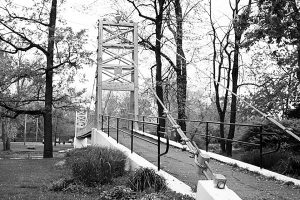
We received research assistance from a former employee of the Indiana Department of Transportation. He opined that Mr. Nutt would have done the site layout, determined the span length, determined the necessary height above potential flood waters, and determined the footing depths. Mr. Nutt would then have placed an order with the South Works, who more than likely had an appropriate prefabricated kit on hand.
Mr. Nutt signed a contract in April, guaranteeing a completion date of July 1. He met his deadline, validating the supposition that the bridge was a kit, as materials were quickly and easily obtained.
Mr. Nutt selected Winamac Cement Products Company to do the significant concrete work. That company, founded in 1921, manufactured tile for field drainage. In 1923, they had branched out to bridges, buildings, and other public works projects. According to minutes from the Town of Winamac, in 1922 and 1923, Winamac Cement Products Company and Mr. Nutt bid on a variety of projects, including sewage and sidewalk upgrades and the replacement of town water mains.
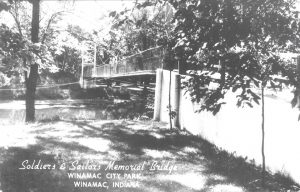 According to two databases, national and international, Memorial is the only suspension-type bridge traversing the Tippecanoe River. It is one of twenty-one suspension bridges constructed in the State of Indiana and one of twelve still standing and in use. It appears to be the third oldest bridge that is still standing. (Some bridges in the databases are not dated.) Originally planned for community development and recreation, by the time the contract was let to Mr. Nutt on April 6, 1923, local leaders had decided to dedicate the bridge to Pulaski County soldiers of all wars, thus the name, Memorial.
According to two databases, national and international, Memorial is the only suspension-type bridge traversing the Tippecanoe River. It is one of twenty-one suspension bridges constructed in the State of Indiana and one of twelve still standing and in use. It appears to be the third oldest bridge that is still standing. (Some bridges in the databases are not dated.) Originally planned for community development and recreation, by the time the contract was let to Mr. Nutt on April 6, 1923, local leaders had decided to dedicate the bridge to Pulaski County soldiers of all wars, thus the name, Memorial.
Historic Context
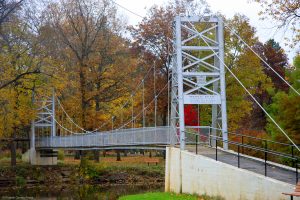 The land now occupied by the Town Park is situated on a natural and beautiful peninsula in the horseshoe bend of the Tippecanoe River. Tradition holds that this area had been a Native American campground. By the time White settlers began to populate the area, all Native Americans had been removed.
The land now occupied by the Town Park is situated on a natural and beautiful peninsula in the horseshoe bend of the Tippecanoe River. Tradition holds that this area had been a Native American campground. By the time White settlers began to populate the area, all Native Americans had been removed.
They were removed permanently from Indiana in 1838, in a forced march that was named the Trail of Death. This march was started at Twin Lakes, a mere 22 miles northeast of Winamac.
White settlers began to populate the area of Monroe Township, where Winamac is now, in that same year, 1838. From that time, pedestrian travel from the settlement, then town, to the peninsula had been with temporary bridges, then a series of “permanent” bridges that could not outlast the river, and finally, again, temporary wooden bridges placed “in season.”
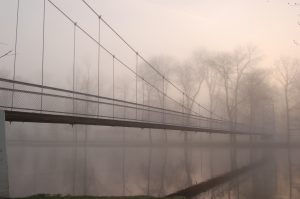 When Winamac was platted in 1839, the peninsula and some surrounding properties were owned by W. C. Barnett, a pioneer resident. A county map published in 1873 shows the property still in his name. The area was known as Barnett’s grove, or Barnett’s peninsula. It was used as pasture for milk cows. Some of the virgin timber had been cut off, but it was still heavily wooded with second-growth trees.
When Winamac was platted in 1839, the peninsula and some surrounding properties were owned by W. C. Barnett, a pioneer resident. A county map published in 1873 shows the property still in his name. The area was known as Barnett’s grove, or Barnett’s peninsula. It was used as pasture for milk cows. Some of the virgin timber had been cut off, but it was still heavily wooded with second-growth trees.
In 1891, the land was purchased by John C. Nye, then a Winamac attorney, later to become Judge of the Circuit Court. He had plans for a park that would attract large crowds of people willing to pay admission to attractions that would be scheduled. While he owned it, each summer, a wooden footbridge was put across the river from some point near the artesian well to the park. The bridges would be erected in time for the annual Old Settlers’ picnic and would remain in place until high water or ice removed it. No bridge ever survived the winter and some had to be replaced before they had been in use for a month.
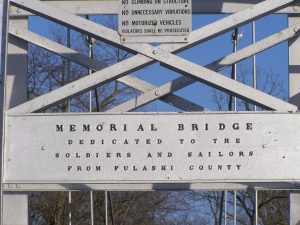
The temporary bridges were made of long-legged trestles set in the bed of the stream where it was fairly shallow. These supported boards that were laid lengthwise. Side railings were fastened to uprights. The bridges had to be taken down each fall, as ice during the winter would ruin it.
While Mr. Nye owned the land, from 1891 to 1908, Mr. Nye allowed citizens to use the peninsula as a park. The 1907 Plat Map of Winamac records it as “Nye Park.”
When Mr. Nye sold the land in 1908, the new owner planned to clear the trees and construct buildings for private use. Citizens joined together to save the land, and the Winamac Park Association was formed. The organization purchased the land, allowing the “river park” to be used free-of-charge by citizens. Fourteen years later, in 1922, the Park Association reincorporated in order to raise funds. At the end of 2021, the Winamac Kiwanis Club had been formed. The two organizations joined forces and imagined Winamac as a tourist destination.
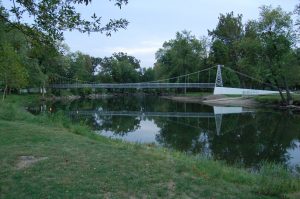 The Park Association raised enough money to improve the river park on the peninsula. They purchased and installed new playground equipment, bath houses, a band stand, a dance pavilion and other amenities. A dedication ceremony was held on July 23, 1922, to celebrate the newly outfitted park.
The Park Association raised enough money to improve the river park on the peninsula. They purchased and installed new playground equipment, bath houses, a band stand, a dance pavilion and other amenities. A dedication ceremony was held on July 23, 1922, to celebrate the newly outfitted park.
It can’t be determined from Town minutes, but either the descendants of Mr. Nye approached the Kiwanis Club, or the Club approached them. They family still owned land on the west side of the river. The plots of land included the already-historic Artesian Well, discovered by accident in 1887 by the Winamac Gas and Oil Company. The high hopes of a “big boom” for the town were dashed when, instead of oil or natural gas, the company struck artesian water. The area by the Artesian Well was also the site of two local fords from the town to the park and the place that both permanent and temporary bridges were placed, at the foot of either Main Street or Pearl Street.
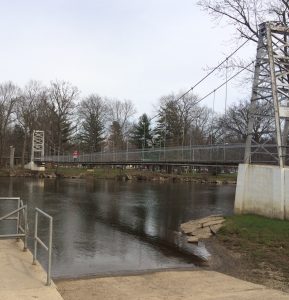 A representative of the Kiwanis Club approached the Town Council with the idea of purchasing the land. Minutes were not specific, and it is unknown if the Town, at that time, envisioned another public park. While their intent was not clear in the minutes, they were amenable to the purchase. Water Street was vacated, and by 1923, this area had become a campground. The work of preparing the property fell to Kiwanis.
A representative of the Kiwanis Club approached the Town Council with the idea of purchasing the land. Minutes were not specific, and it is unknown if the Town, at that time, envisioned another public park. While their intent was not clear in the minutes, they were amenable to the purchase. Water Street was vacated, and by 1923, this area had become a campground. The work of preparing the property fell to Kiwanis.
Either through invitation or self-driven in this regard, R. E. Nutt spoke to the Park Association about a suspension bridge that he believed could be installed for $2,000. The Association approached the Town, asking them to share expenses on a 50/50 basis. The Town agreed, so long as they did not have to pay more than $1,000. Minutes from the Park Association were not found, but the two local newspapers kept townspeople up to date about plans for a bridge, a permanent bridge that would connect pedestrians from the town to the park, that would allow out-of-town campers to make use of park facilities. The Park Association announced that bids would be received for a permanent bridge, with a requirement that it be completed by June 1. While they expected several quotations, only Mr. Nutt placed a bid.
By the time the quotation was developed in March, prices of cement and steel had risen dramatically. The bid was for $3,197. The Town was represented at the meeting, steadfast in its determination to pay no more than $1,000. The bid was tabled to allow the Association to meet with Kiwanis and determine a path forward. Before that meeting could take place, however, a member of the Association went from business to business to raise funds. $1,600 was raised in a matter of days, giving them hope of moving forward.
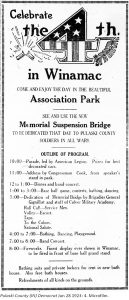
One has to consider the time. In 1923, The War to End All Wars was still a raw memory. Pulaski County delivered 662 men to the War; thirty-three did not return. When the contract was signed with Mr. Nutt on April 6, 1923, the combined group of town leaders had determined the bridge should be dedicated to “soldiers and sailors” from the Civil War forward. Thus, it would be named “Memorial.” The completion date was pushed to July 1. Mr. Nutt left almost immediately for Chicago to procure supplies, and construction was underway by early May.
While Memorial was under construction, the Kiwanis Club put their members to work. The new town park was given a general clean-up and put in shape for use by auto tourists. “Combination dining tables and seats for the use of picnic parties” were constructed. These were rather a new idea. They may have been around for a while, but the first patent for a picnic table was filed in 1903. The Kiwanis Club was on the cutting edge with this installation. Two camp stoves were erected and a cinder walk from the well to the footbridge was installed.
On the “river park” side, the Park Association made additional improvements. A twenty-foot-wide graded cinder drive from the road entrance to the park was installed to enable two rows of cars to pass. It extended through the park as far as the bathing bench. Another band stand was erected with lumber remaining from the previous footbridge, and a permanent refreshment stand was built that contained kitchen conveniences and refrigerator.
Suspension Bridges in Indiana
Suspension-type bridges are rare in the State of Indiana, especially of this age. Three suspension bridges in Indiana are listed on the Indiana Sites and Structures Inventory. The Turkey Run Suspension Bridge, built in 1917-18 is listed as outstanding. The Foster Park Footbridge in Fort Wayne, built in 1920, is listed as a contributing resource to the park. Indiana State Highway Bridge Number 154-77-06536, the Sullivan-Hutsonville suspension bridge, was built in 1939 but has been demolished. Based on research of the Bridgemeister.com and BridgeHunter.com websites, Memorial could be the third oldest suspension bridge in Indiana still in operation. (Several are undated.)
Local Significance
Memorial has been an important part of the recreation and culture of Winamac and Pulaski County since 1923. Owned by the Town, it is nevertheless a County icon, used by countless children, adults and families to traverse the river by foot from one park to the other, or to stand in the middle and watch the river, or to gather for senior class pictures.
For walkers, the bridge is part of the mapped walking trail in the town park system.
For veterans, the bridge holds a particular significance, because it stands as a permanent testament to their service and sacrifice.
State Significance
Suspension bridges in Indiana are rare. Of the twenty-one listed in a combination of online registries (Bridgemeister and Bridgehunter), only twelve remain standing. Memorial appears to be the third oldest that remains standing and in use. (Some bridges are not dated.) The two that are older (constructed in 1918 and 1920) are listed on the Indiana Sites and Structures Inventory.
